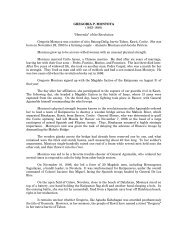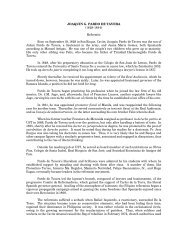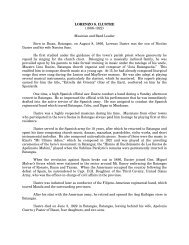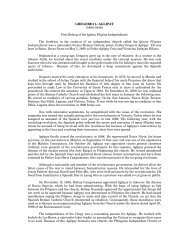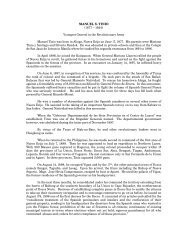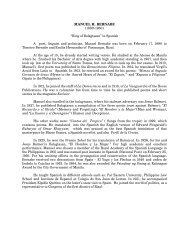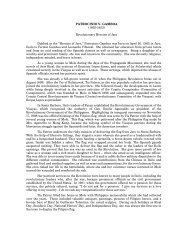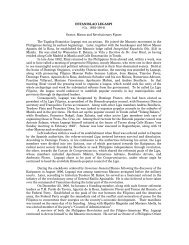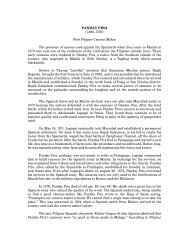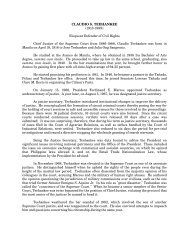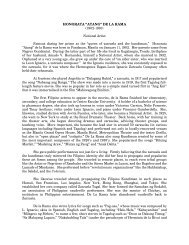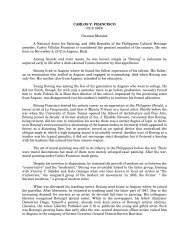DOMINADOR GOMEZ - National Historical Commission of the ...
DOMINADOR GOMEZ - National Historical Commission of the ...
DOMINADOR GOMEZ - National Historical Commission of the ...
You also want an ePaper? Increase the reach of your titles
YUMPU automatically turns print PDFs into web optimized ePapers that Google loves.
<strong>DOMINADOR</strong> <strong>GOMEZ</strong><br />
(1868-1929)<br />
Physician, Propagandist, Labor Leader and Legislator<br />
Born in Manila in 1868, Dominador Gomez studied medicine at <strong>the</strong> University <strong>of</strong><br />
Santo Tomas but finished <strong>the</strong> course in Madrid.<br />
While a medical student in Madrid, he joined <strong>the</strong> group <strong>of</strong> young and patriotic<br />
middle-class Filipinos <strong>of</strong> intelligence, courage, and prominence that had organized <strong>the</strong><br />
Propaganda Movement to work in Spain for political and social reforms in <strong>the</strong><br />
Philippines. Dr. Jose Rizal and Marcelo H. del Pilar led <strong>the</strong> group.<br />
An essayist and a brilliant orator, he supported <strong>the</strong> movement with both his pen<br />
and his tongue. He wrote under <strong>the</strong> pseudonym, “Ramiro Franco,” for its organ, La<br />
Solidaridad. He helped finance <strong>the</strong> publication <strong>of</strong> this periodical from 1889 to 1895.<br />
Upon his return to <strong>the</strong> Philippines, Gomez took over from Isabelo de los Reyes<br />
<strong>the</strong> leadership <strong>of</strong> <strong>the</strong> newly reorganized Union Obrero Democratica de Filipinas, <strong>the</strong><br />
first labor union in <strong>the</strong> Philippines, and became its president. As an ilustrado-labor<br />
leader, he was tapped by <strong>the</strong> Americans to talk with Macario Sakay. He was instrumental<br />
in convincing Sakay to come down from <strong>the</strong> mountains. The cessation <strong>of</strong> hostilities<br />
would mean <strong>the</strong> grating <strong>of</strong> <strong>the</strong> certificate <strong>of</strong> peace by <strong>the</strong> Philippine <strong>Commission</strong>, which<br />
was a prerequisite for <strong>the</strong> holding <strong>of</strong> election for <strong>the</strong> Philippine Assembly. The Assembly,<br />
Gomez told Sakay, was a step nearer to full independence. He agitated for <strong>the</strong><br />
observance <strong>of</strong> Labor Day in <strong>the</strong> Philippines on May 1 <strong>of</strong> each year (In 1913, <strong>the</strong> Philippine<br />
Legislature declared this date <strong>of</strong>ficially as Labor Day). Although he was arrested and<br />
sentenced to hard labor for his militant union activities, he considered himself<br />
vindicated with his election as a delegate to <strong>the</strong> first Philippine Assembly in 1907.<br />
Ever loyal to his racial heritage and patriotic spirit, Gomez attempted with Pedro<br />
A. Paterno and Pascual H. Poblete to organize in 1900, and again in 1901, <strong>the</strong><br />
Nacionalista Party, which was in favor <strong>of</strong> securing outright independence for <strong>the</strong><br />
Philippines, ra<strong>the</strong>r than autonomy or annexation to <strong>the</strong> United States, <strong>the</strong> stand <strong>of</strong> <strong>the</strong><br />
opposing party. In later years, however, he identified himself with <strong>the</strong> Federo-Tercerista<br />
group, also known as <strong>the</strong> Democratic Progresistas, in opposition to <strong>the</strong> powerful<br />
Nacionalistas.<br />
Gomez’s controversial involvement in politics started with his election to <strong>the</strong><br />
Philippine Assembly, from which he was later ejected. He blamed his expulsion on both<br />
Speaker Osmeña and Assemblyman Manuel L. Quezon, whom he accused <strong>of</strong> having<br />
“availed <strong>the</strong>mselves <strong>of</strong> all means and opportunities against him for fear that he might<br />
take hold <strong>of</strong> <strong>the</strong> gavel and with it <strong>the</strong> speakership.”<br />
He and Quezon were bitter political foes. They even had a date to fight a duel<br />
sometime in 1915, but close friends <strong>of</strong> <strong>the</strong> two protagonists prevailed upon <strong>the</strong>m to desist<br />
from it. Their mutual hatred stemmed from Quezon’s allegations against Gomez’s<br />
character which were aired on <strong>the</strong> floor <strong>of</strong> <strong>the</strong> US Senate, when Quezon was <strong>the</strong> resident<br />
commissioner <strong>of</strong> <strong>the</strong> Philippines to Washington, D.C..
In 1916, Gomez became president <strong>of</strong> <strong>the</strong> municipal board <strong>of</strong> Manila, to which he<br />
had earlier been elected a member. He proved to be a crusading alderman. His first<br />
<strong>of</strong>ficial act was to call <strong>the</strong> attention <strong>of</strong> his colleagues to <strong>the</strong>ir responsibilities to <strong>the</strong>ir<br />
constituents.<br />
While <strong>the</strong> Philippines was still a colony <strong>of</strong> Spain, Gomez served as a volunteer in<br />
<strong>the</strong> Spanish army in <strong>the</strong> war in Cuba, and was decorated by Queen Maria Cristina for his<br />
bravery.<br />
References:<br />
He died in 1929.<br />
Gwekoh, Sol. “D. Gomez: Crusading labor chief,” The Manila Times, 1965.<br />
Roces, Alfredo ed. Filipino Heritage Volume 9. Lahing Pilipino Publishing Inc.,<br />
Philippines, 1978.<br />
Zaide, Gregorio F. and Sonia Zaide, Documentary Sources <strong>of</strong> Philippine History,<br />
<strong>National</strong> Bookstore, Inc., Manila, 1990.



